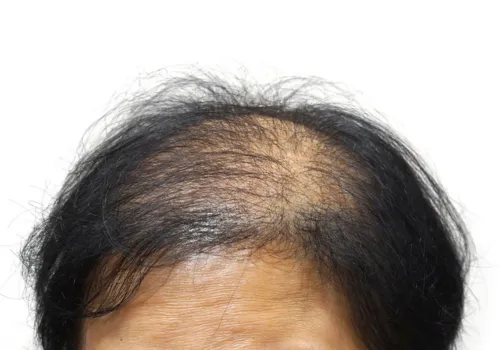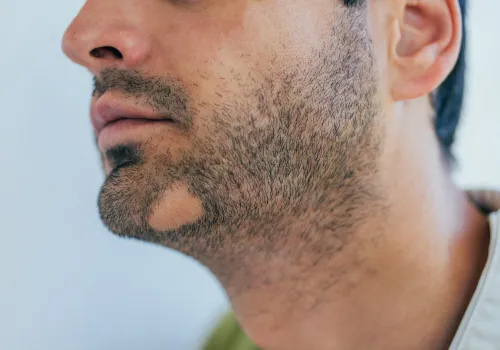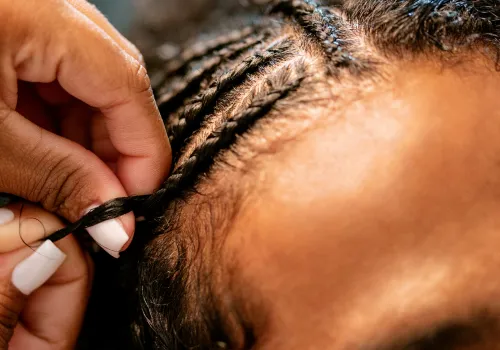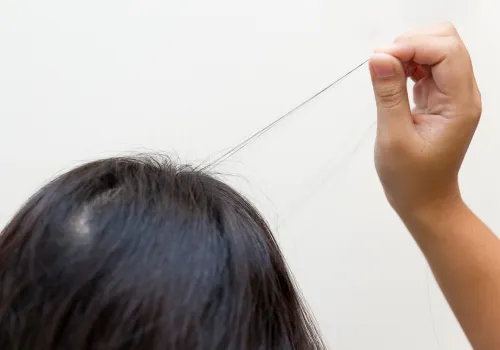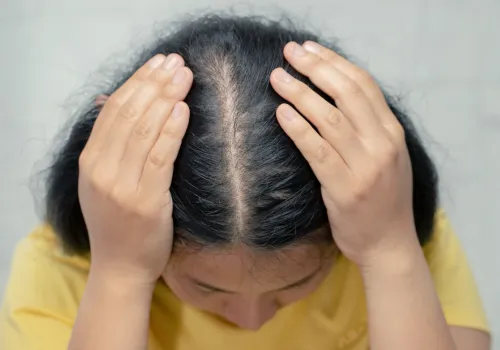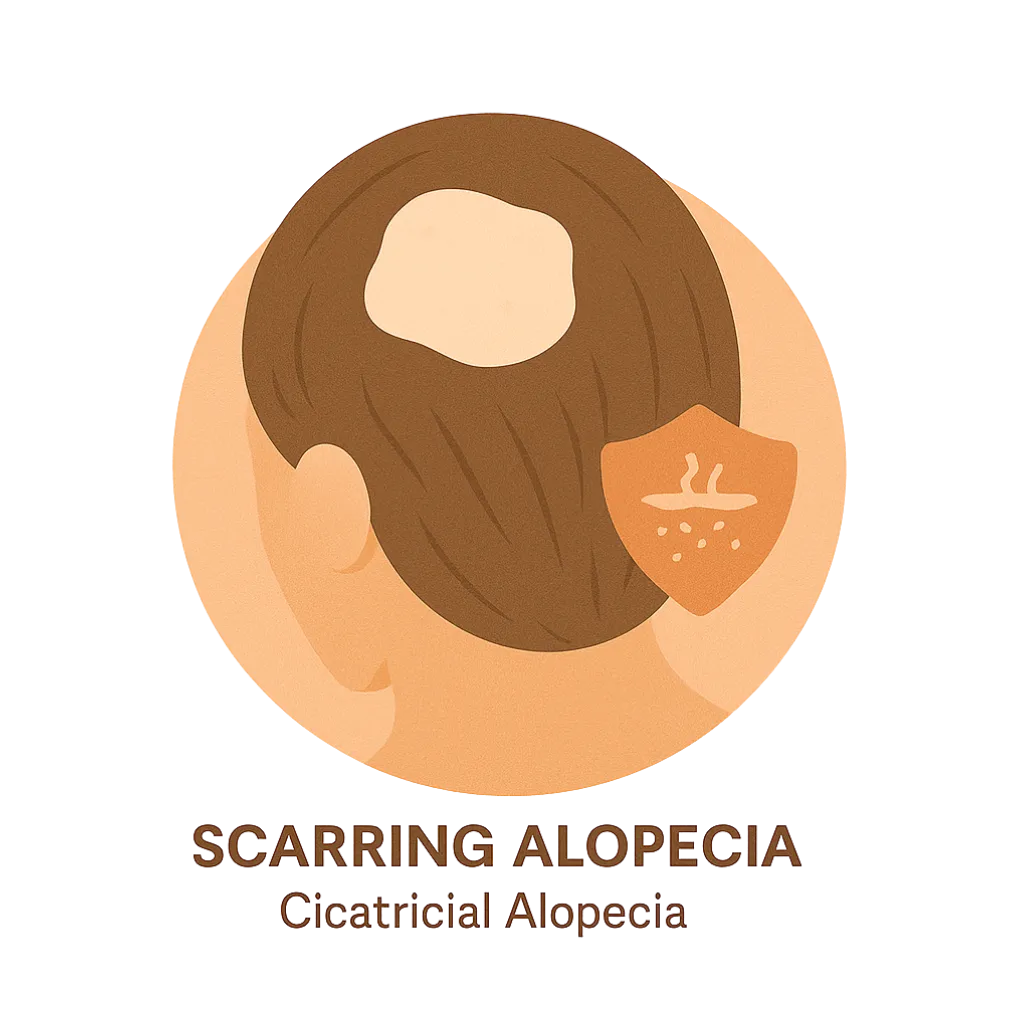
Scarring Alopecia
(Cicatricial Alopecia)
A group of rare disorders that destroy hair follicles and replace them with scar tissue. This form of hair loss is often permanent and requires early diagnosis and care to prevent progression.
Scroll to Learn More
A group of rare inflammatory disorders that destroy hair follicles and replace them with scar tissue, leading to permanent hair loss.
What is Scarring Alopecia?
Scarring Alopecia—also called Cicatricial Alopecia—is a category of hair loss conditions characterized by permanent destruction of the hair follicle due to inflammation. As the follicle is destroyed, it’s replaced with scar tissue, preventing hair from regrowing.
There are many types of scarring alopecia, including Lichen Planopilaris (LPP), Frontal Fibrosing Alopecia (FFA), Central Centrifugal Cicatricial Alopecia (CCCA), and Folliculitis Decalvans. These conditions can progress silently or rapidly, and early intervention is critical to prevent permanent loss.
Common Causes & Contributing Factors
Autoimmune activity– The immune system attacks healthy follicles
Chronic inflammation – From infections, trauma, or systemic conditions
Hormonal shifts – Especially in postmenopausal women (e.g., FFA)
Chronic stress or trauma – High cortisol can modulate immune responses
Genetics – Some types (like CCCA) may be more common in specific populations
Scalp infections – Deep bacterial or fungal infections can cause follicle damage
Delayed diagnosis or mismanagement – Increases risk of irreversible loss
Don't worry, we can help!
What You Might Notice
Patches of shiny, smooth scalp with no visible follicles
Redness, scaling, or pustules around the hairline or crown
Burning, itching, or pain in the affected area
Hair breakage that worsens over time
Sudden onset or slow progression depending on subtype
How It’s Diagnosed
Early diagnosis is essential. A professional may perform:
Trichoscopic (scalp microscope) examination for signs of inflammation or follicle dropout
Scalp biopsy to confirm presence of scar tissue and identify type
Functional blood testing to assess autoimmune patterns, inflammation, nutrient status, and liver/gut health
Medical history review and symptom tracking
Referral to a dermatologist is often required to confirm the diagnosis and rule out similar conditions.
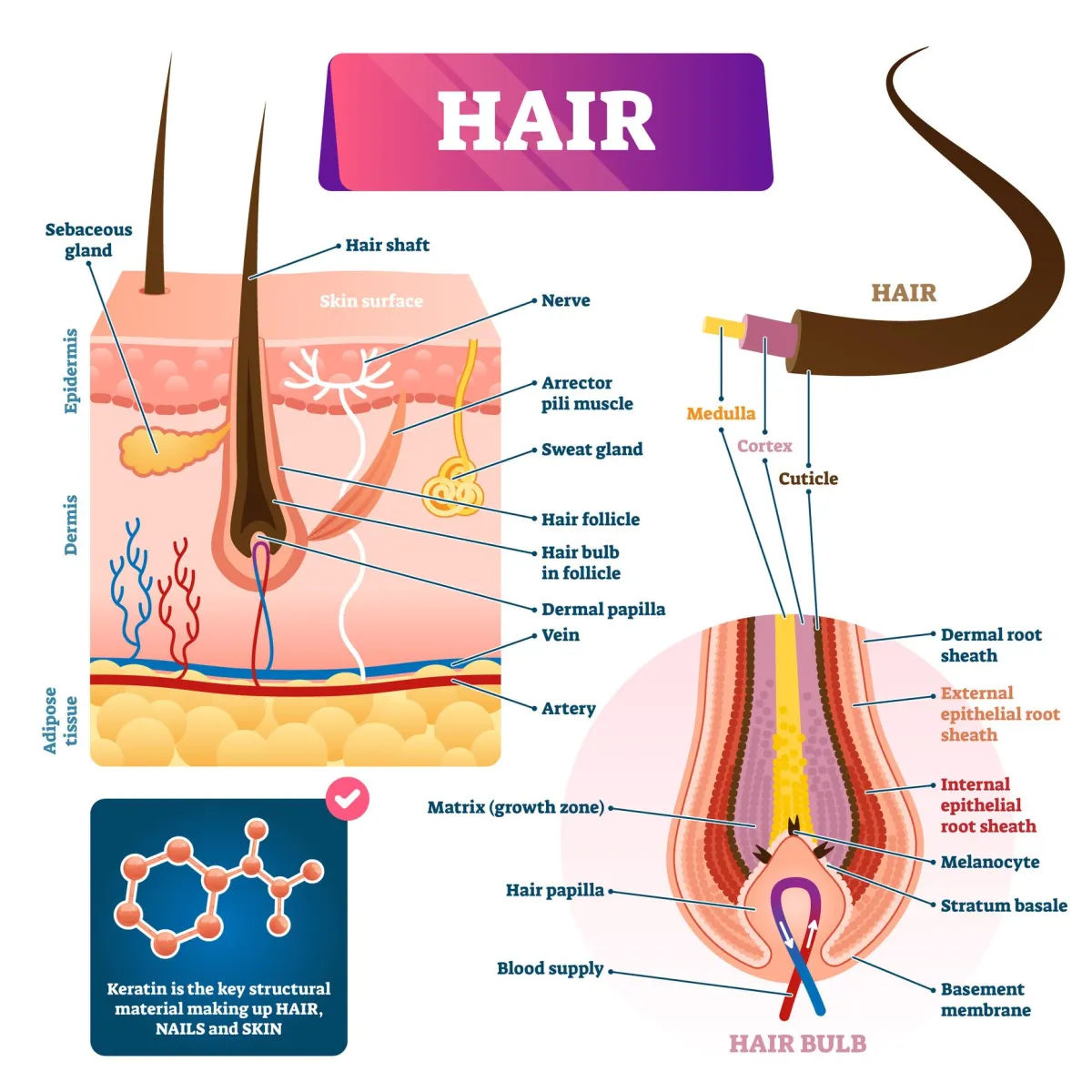
Treatment & Management Options
Lifestyle Recommendations
Anti-inflammatory diet rich in whole foods, antioxidants, and essential fats
Eliminate triggers (e.g., processed foods, environmental toxins)
Reduce stress load with sleep support, breathwork, and adrenal adaptogens
Topical / Clinical Treatments
Topical anti-inflammatory agents: natural (turmeric, green tea extract) or prescribed (clobetasol, tacrolimus)
Microneedling to trigger follicle stimulation
Ozone therapy to reduce microbial load and oxygenate the scalp
Microneedling or PRP (only if active inflammation has subsided)
Scalp Therapies & Supplements
Functional nutrients: vitamin D, zinc, biotin, quercetin, omega-3s
Gut-healing protocol (if bioscans show leaky gut, dysbiosis, or candida)
Scalp detox with Iridium Green Shampoo and Cell Food Drops


Not ready to book a session just yet?
That’s okay—your curiosity still matters! If you have a question about hair or scalp health but aren’t ready to move forward with a consultation, feel free to send it our way. We may feature it in an upcoming blog post or use it as a topic in a future live session—because chances are, someone else is wondering the same thing too.
Scarring Alopecia (Cicatricial Alopecia) Blog
We regularly share content on this topic through both video and written posts. Use the search bar to find answers to the specific questions you're looking for.
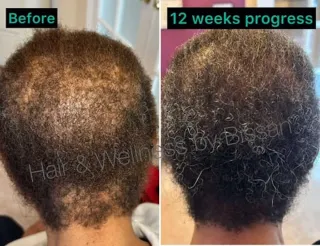
Case: Multiple Types of Alopecia
Hair loss can be overwhelming, especially when dealing with multiple types of alopecia. This case study shares how a woman in her 60s, after failed treatments, found hope through a whole-body approach... ...more
Androgenetic Alopecia ,Telogen Effluvium Alopecia Areata Scarring Alopecia Traction Alopecia Trichotillomania Hormonal Hair Loss Nutritional Deficiency Trichology &Bissan
November 28, 2024•4 min read
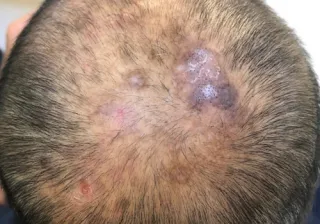
Cicatricial Alopecia
Scarring alopecia, or Alopecia Cicatricial, is a permanent form of hair loss caused by inflammation that destroys hair follicles and replaces them with scar tissue. In this post, we explore the causes... ...more
Scarring Alopecia ,kerrijarrett
August 24, 2023•2 min read

Hair Loss
Explore the world of trichology—the scientific study of hair and scalp health. This blog offers expert insights from certified trichologists on common conditions like hair loss, dandruff, scalp itchin... ...more
Alopecia Areata ,Scarring Alopecia Traction Alopecia Trichotillomania Hormonal Hair Loss Nutritional Deficiency Trichology &kerrijarrett
February 21, 2023•3 min read
"I was misdiagnosed for two years and lost so much hair before finding out it was Lichen Planopilaris. Working with a team that focused on gut health, inflammation, and gentle scalp support made all the difference."
– Client, Age 52
Real Stories. Real Experiences.
You’re Not Alone with Alopecia Areata
Alopecia Areata can be unpredictable, but you don’t have to face it alone. This community was built to support and uplift — real people with real experiences, just like yours. We’re here to listen, share, and grow together.
Understanding Cicatricial Alopecia Starts Here
We’ve gathered the most insightful, supportive, and educational videos on Cicatricial Alopecia so you don’t have to search alone. Learn the science. Hear real experiences. Feel less alone.
This playlist was designed to help you feel empowered and informed every step of the way.
CLICK BELOW TO WATCH FIRST!
Are You a Hair & Scalp Professional? Join the Faculty of Trichology
Whether you're already an expert, just getting started, or looking to deepen your specialty—we’ve got something for you.
The Faculty of Trichology is where professionals come to elevate their skills, build their credibility, and connect with a network that takes hair and scalp health seriously.
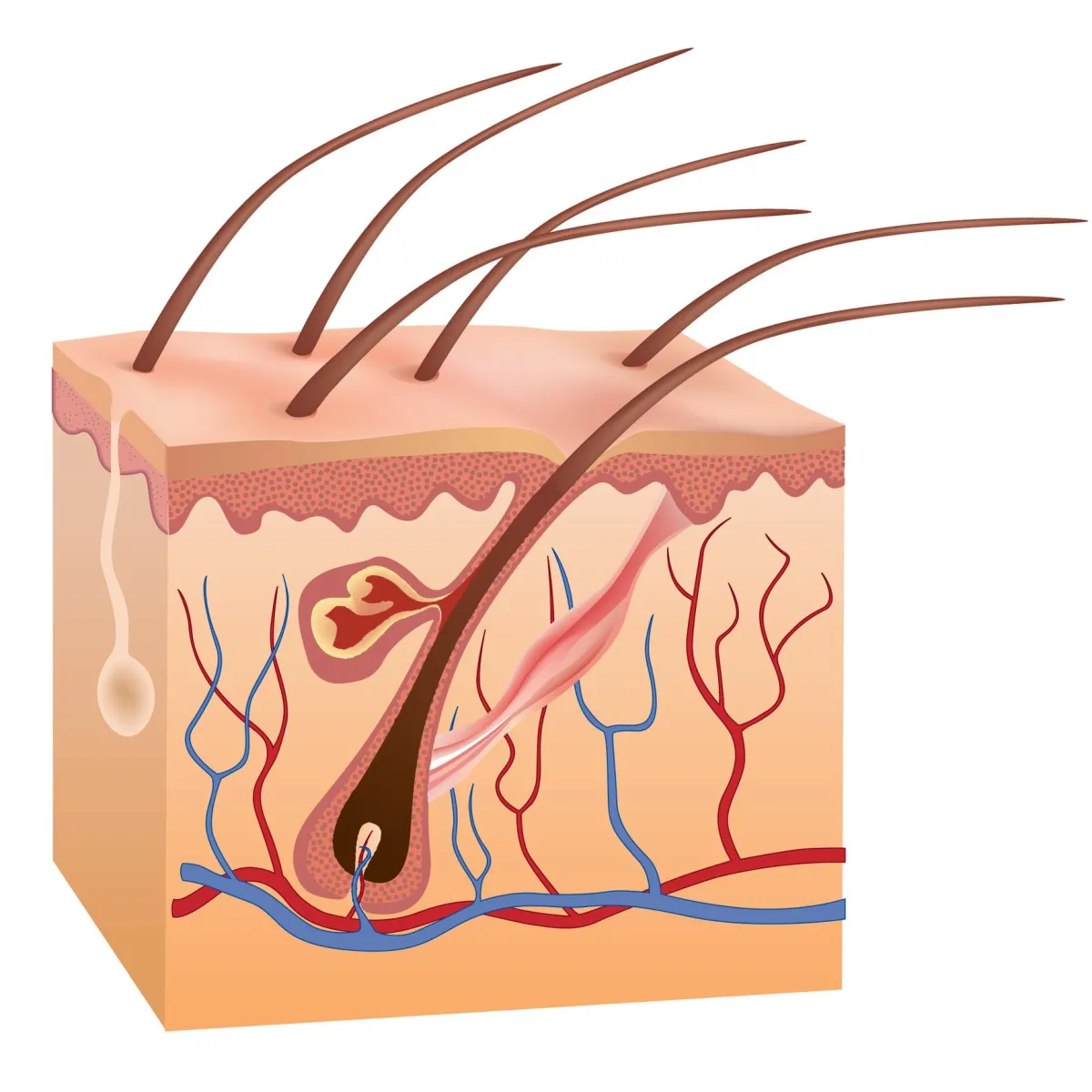
Cicatricial Alopecia FAQ
What is Scarring Alopecia (Cicatricial Alopecia)?
Scarring Alopecia refers to a group of rare disorders that permanently destroy hair follicles, replacing them with scar tissue. Unlike non-scarring forms of hair loss, once a follicle is damaged by inflammation and replaced with fibrosis, hair cannot grow back. Early diagnosis is crucial, which is why we at The Hair Wire encourage people to pay attention to subtle symptoms—not just visible loss.
What causes Scarring Alopecia?
The exact cause can vary depending on the subtype (like Lichen Planopilaris, Frontal Fibrosing Alopecia, or Central Centrifugal Cicatricial Alopecia). It often involves inflammation, autoimmune responses, and environmental triggers. Research in epigenetics suggests a link between immune activity, hormonal shifts, and external stressors, which may explain why onset often coincides with lifestyle disruptions.
How is Scarring Alopecia different from other types of hair loss?
Most types of hair loss (like Telogen Effluvium or Alopecia Areata) are non-scarring, meaning the follicle remains intact and capable of regrowth. In scarring alopecia, the follicle is permanently destroyed, often starting with subtle symptoms like burning, tenderness, flaking, or redness—well before actual hair loss is visible. That’s why early awareness and intervention matter.
Is Scarring Alopecia reversible?
Once scarring occurs, it’s permanent. However, with early diagnosis and a tailored treatment plan, progression can be slowed or even halted. At The Hair Wire, we emphasize early detection, lifestyle mapping, and collaboration with dermatologists and trichologists to manage the condition proactively and preserve as much healthy follicular tissue as possible.
What are the early signs of Scarring Alopecia?
- Burning, itching, or tenderness of the scalp
- Redness or inflammation around the follicle
- Pustules or scaling
- Shiny, smooth areas where hair once grew
These signs are often overlooked or misdiagnosed as dermatitis or dandruff. At The Hair Wire, we teach professionals to read the signs early—to prevent permanent damage through informed care.
What treatments are available for Scarring Alopecia?
There’s no universal cure, but treatment focuses on controlling inflammation and halting further follicle destruction. Options may include:
Topical and oral corticosteroids
- Anti-inflammatory antibiotics
- ImmunomodulatorsLow-level light therapy (in some cases)
Lifestyle factors like reducing stress, managing inflammation through diet, and gentle scalp care also play a supporting role.
Can stress or lifestyle contribute to Scarring Alopecia?
While not a direct cause, stress, diet, hormonal imbalances, and inflammation can exacerbate autoimmune activity and disrupt immune regulation. Through an epigenetic lens, we see that what you eat, how you rest, and how you manage emotional stress can all influence the body’s immune landscape. That’s why we advocate for integrative care on The Hair Wire—treating the person, not just the symptom.
Is Scarring Alopecia hereditary?
There can be a genetic predisposition, especially in forms like Central Centrifugal Cicatricial Alopecia (CCCA), which predominantly affects Black women. However, lifestyle, hormonal health, and environmental triggers play significant roles in whether these genes “switch on.” This is why education and early intervention matter—even for those with family history but no symptoms yet.
How is Scarring Alopecia diagnosed?
Diagnosis typically requires:
- Trichoscopic (scalp microscope) examination
- Detailed health and lifestyle intake
- Scalp biopsy to confirm inflammation and scarring
Our approach at The Hair Wire includes empowering both professionals and clients to ask the right questions, understand the language of the scalp, and seek biopsy referrals when red flags appear.
What should I do if I think I have Scarring Alopecia?
- Don’t wait. Book an assessment with a trichologist or dermatologist familiar with hair loss.
- Track your symptoms, including pain, redness, and shedding patterns.
- Avoid aggressive styling or chemical treatments.
- Request a biopsy if inflammation is present.
And most importantly—get informed. You’re not alone, and there is a path forward. Education is the first step to reclaiming agency, and The Hair Wire is here to walk with you—through clinical clarity and compassionate care.

We’re more than hair. We’re a community, an education platform and a movement.
Our mission is to raise the standard — reigniting the heart of this industry with integrity, purpose, and connection. We’re also committed to bridging the gap between cosmetology, dermatology, and general practice, creating a more collaborative and informed approach to hair and scalp health.
ABOUT
The Hair Wire is a trusted resource created by trichologists, for anyone seeking clarity around hair and scalp health. With clinically backed information, we simplify complex hair loss conditions and offer professional insight, education, and solutions—one strand at a time.
DISCLAIMER
The content on The Hair Wire is intended for educational and informational purposes only. It is not a substitute for medical advice, diagnosis, or treatment. While our material is guided by professional experience and clinical trichology, we encourage individuals to consult with their own healthcare or wellness providers when making personal health decisions. The Hair Wire offers professional insights, not medical directives.
PATRON ACCESS
PRO' ACCESS
© Copyright 2025. The Hair Wire / Facutly of Trichology. All rights reserved.
